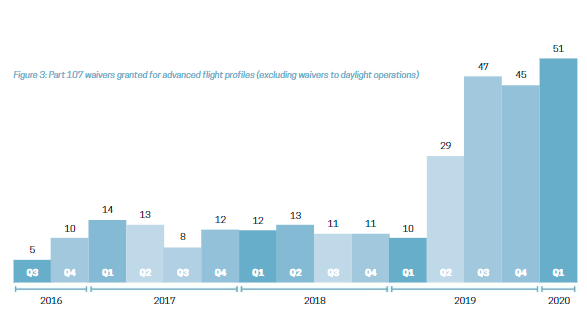The Association for Unmanned Vehicle Systems International (AUVSI) has published an analysis of waivers issued for Unmanned Aircraft Systems (UAS) under Part 107 – affecting civil drone flights weighing more than 55 pounds and operating beyond visual line of sight and/or outside daylight hours. The New Part 107 Waiver Report – Analysis of Advanced Operations Granted by the FAA details the flights, applications, and trends over four years.
According to AUVSI, The US Federal Aviation Administration (FAA) has issued almost 4,000 waivers in the four years since Part 107 was issued in August 2016. This shows about 95% enable UAS flights at night. The other 5% allow more advanced flight profiles like those over people, in excess of 100 mph, beyond line of sight of the operator, higher than 400 ft, or limited flight visibility. Ground control requirements can also be modified. However, approvals for these more complex flights have accelerated over the past 18 months and represent over half the waivers granted in the last year. This supports the need to develop rule making for operations beyond the imposed limits of Part 107, says AUVSI.
The report finds commercial business operators account for over 72% of waivers; first responders comprise 19%, mainly night-time operations. Small businesses predominate, with 87% of operators generating less than USD1 million in annual revenue. “As such, it is important that the waiver process be standardised and easy to navigate to ensure that small businesses with minimal resources are able to take advantage of the benefits enables by advanced operations,” says the report.
The report finds Part 107 waiver application process is “cumbersome, inconsistent, and nonconforming in the evolving nature of waiver requests. Long term solutions to these challenges involve further rulemaking. In the meantime, it is important that the current process continue to be improved.”
AUVSI President Brian Wynne says: “The waivers that have been granted so far demonstrate that operators are safely able to conduct expanded operations, such as flights over people and beyond visual line of sight. While improvements to the waiver process are needed and welcomed, we urge the FAA to move forward rapidly with rulemakings that would widely enable these operations and provide the economic and societal benefits they offer.”
For more information visit:
https://issuu.com/auvsi3/docs/2020_waiver_update?fr=sYzFlODEyNDA0MDI




